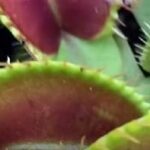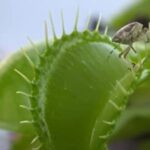As an Amazon Associate, this site earns commissions from qualifying purchases. For more details, click here.
One of the most common questions new Venus flytrap owners ask is why some of the leaves turn black. Is it a sign the plant is dying and should you cut it off? What should you do about it? We will answer all those questions in detail because it is important for plant owners to know what steps to take..
Venus flytrap leaves turn black due to old age, overfeeding or dormancy, but it will not affect the entire plant. You can trim dead, blackened leaves with pruning shears or just leave it there, it will not cause any harm.
Should I Remove Black Venus Flytraps?
You can either trim the dead leaves or just wait for it to fall off. Eventually the leaves will wither and die without harming the rest of the Venus flytrap.
In rare cases mold might set in and spread throughout the plant. But this usually happens to Venus flytraps that are already sick. As long a the plant gets hours of sunlight, water and nutrients, mold will not spread.
If you decide to remove black Venus flytraps, how often should you do it? Most cultivators trim Venus flytrap leaves at the end of each season. It is easier to cut off the leaves after growth season, but it is up to you.
If you have a lot of Venus flytraps, removing black leaves over and over can get tedious. There is no need to cut a leaf every time it turns black as it will not hurt the plant.
You can trim all black Venus flytraps every month if you do not want to wait for growth season to end. But this is purely for cosmetic reasons.
Will Black Venus Flytraps Mold?
The chances of mold is very low. As long as you take preventive steps, plant molding will not be an issue.
Molding in dead leaves affects Venus flytraps that receive insufficient lighting. This can happen if the plant is not getting enough light. if your Venus flytrap is indoors, place it on a windowsill or use artificial fixtures like GooingTop LED Grow Lights. These are ideal if there is not enough sunlight in your area.
With enough light your Venus flytrap is fine. Leaves that turn black is normal. If you do trim off the leaves, take care not to cut any healthy ones as well as roots and stems.
Even in dormancy Venus flytraps will need those stems for photosynthesis, and you should still see some green leaves there. A dormant Venus flytrap is different from a dying one as it will arise again in spring.
How Do I Trim Black Venus Flytraps?
Use a pair of sharp cutters to cut the black leaves. We suggest Fiskars Pruning Shears because they are made specifically for gardening and make trimming easy.
Wait for the leaves to wither before trimming. Do not cut any healthy roots, stems or leaves. Do not cut with dull scissors because it will require multiple attempts, increasing the chances of accidentally snipping healthy leaves.
Some suggestions:
- You can trim black leaves anytime with one Venus flytrap. But if you have several it will take a lot of time. In this case you should set a trimming schedule for all your plants.
- Do not not pick off the leaves with your hand. This is not leaf pulling where you try to reproduce Venus flytraps. Just cut the blackened leaves with your scissors and the plant will be fine.
- Do not uproot the plant unless you are repotting it. Black leaves do not mean root rot, so resist the urge to check the root.
- If you are repotting the plant, you can check its bulb (rhizome) for any black spots.
What Happens After You Trim Black Venus Flytraps?
Trimming black leaves does not do any harm or good to the plant. But most Venus cultivators prefer to do it for aesthetics. Nobody wants to see black leaves or traps on their Venus flytrap so why not remove them? But there is another reason to trim them off.
Cutting off dead leaves allows a Venus flytrap to use its resources elsewhere. As long as the trap is on the plant, a new one cannot grow. The leaf has to wither and fall off first.
By trimming the leaf you can speed up the process a bit. This is most ideal in large species with several leaves. Trimming the dead ones off also gives the plant a more pleasing appearance.
If you are growing a Venus flytrap indoors and it is not getting sufficient light, black, dead leaves should be removed to prevent mold.
Why is My Venus Flytrap Turning Black?
A trap usually turns black because its lifespan is about to end. Most traps last for 90 days and close 3-5 times. Once the black, dead trap falls off or is trimmed, a new one will take its place.
As long as new traps are being produced, your Venus flytrap is healthy. But if you are not seeing any new traps, read on to find other possible reasons why your Venus flytrap turns black.
The Plant is Dormant
Venus flytraps that enter dormancy will not produce new leaves or traps. The plant will shed most of its leaves and look withered, but this is normal.
Venus flytraps require dormancy to grow, so just be patient. When spring arrives you will see leaves sprout and turn bright green again.
There is nothing you can do at this point except wait and water the soil to keep it from drying. Do not give it any insects or any type of food. Once the plant emerges from dormancy, you can start feeding the traps. This can take several weeks or months so patience is the key.
Indigestion
Humans get indigestion when they eat too much or eat something their stomachs do not agree with. The same thing can happen with Venus flytraps.
Venus flytraps should only be fed every one to four weeks. Only one trap needs to eat, though some feed two. But never give food to all the traps as it does more harm than good.
Carnivorous plants eat insects for their nitrogen. Too much of it is not healthy and could kill the trap. Fortunately this will not hurt the rest of your Venus flytrap.
If your Venus flytrap eats insects regularly, there is no need to give it any extra food. That will cause more trouble and could turn several leaves black.
The Prey is Too Big
Venus flytraps can only eat bugs small enough to fit in its trap. If a large insect triggers the sensors, the trap will try to close. But if the bug is too big it will try to fly or eat its way out. This can cause the leaf to turn black and die.
There is nothing you can do here except wait for a new trap to grow. You can trim the dead leaf off or just wait for a new one to take its place.
This can also happen if you are feeding Venus flytraps. Make sure to never fill it to the brim. Once the trap is a third full, that is enough. Tap the hair sensors lightly so the trap closes and digests it.
Overfeeding Venus flytraps is very common and can cause several leaves to turn black. Avoid this and you reduce the chances of Venus flytrap black leaves.
Using the Wrong Soil
Venus flytraps grow in nutrient poor soil. This is the reason why they catch insects, to extract nutrients they cannot get from the ground. Your flytraps must be grown the same way.
Do not use nutrient rich soil because it will harm the plant. If you want to avoid this problem, equal parts perlite and peat moss. This ensures the soil is appropriate for the plant to flourish and grow.
You can also use long sphagnum moss combined with perlite or silica sand. Do not fertilize the soil. You should also use only distilled water. Tap water has minerals that could damage the roots and leaves.
If you do not want to use distilled water, reverse osmosis or rainwater will do. While water is important, Venus flytraps also have other requirements to grow.
The easiest way to approach this is to pick a Venus flytrap variant and learn as much as you can before buying it. This way you will know what to do when you finally buy the plant.
Conclusion
As long as you take proper care of Venus flytraps, those black leaves are nothing to worry about. It is a normal part of its life cycle and you can remove them safely without causing harm.

My fascination with carnivorous plants began many, many years ago with Venus Fly Traps. Now I am more than happy to impart what I know with other enthusiasts and those who are curious about meat eating plants.



